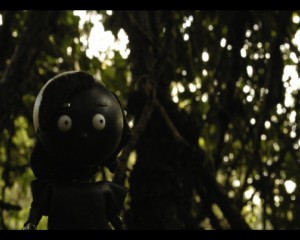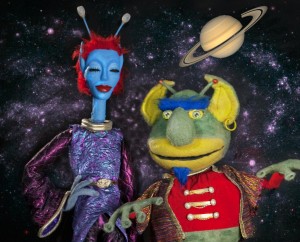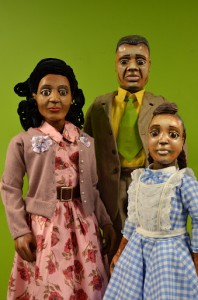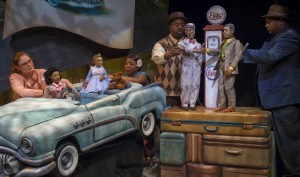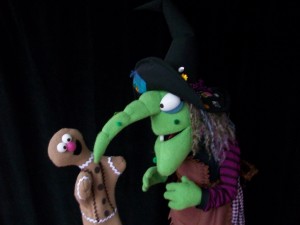When the Center for Puppetry Arts debuted its production of the 1964 Rankin/Bass stop motion holiday favorite Rudolph the Red-Nosed Reindeer last year, it became the first theatre to put on an authorized reproduction of the show. It quickly sold out its entire run, even after adding additional shows to accommodate more guests. This year the show opened just after Halloween and has enjoyed another successful run through Dec. 31.
When they’re not helping tell the story of how Rudolph and his misfit friends overcame insurmountable odds as the Abominable Snowman and a storm that almost forces Santa to cancel Christmas, two of Rudolph’s puppeteers are involved in an entirely different kind of battling known as Platinum Championship Wrestling.
As wife of PCW promoter/booker Stephen Platinum, longtime Center puppeteer Julie Scarborough portrays Mrs. Donner (Rudolph’s mother), Hermey the Elf, the Spotted Elephant and an elf girl. Having been involved with numerous productions at the Center for many years, it was actually a wrestling-themed segment from a puppet show called Weather Rocks (in which a cold front does battle with a warm front in a wrestling ring) that brought her and Platinum together. His acceptance of her invitation to come to a children’s puppet show impressed her so much that she ended up marrying the guy and having a couple of kids with him (the oldest of which was involved in a fetus vs. fetus match at one of Dad’s Garage Theatre‘s B.R.A.W.L. shows a few years ago – while still in the womb!).
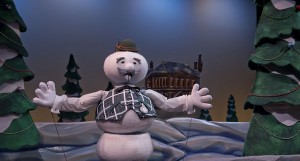
Dolph Amick narrates “Rudolph” as Sam the Snowman. Photo by Clay Walker
It was Scarborough who introduced Platinum to Dolph Amick, another Center vet who portrays Rudolph‘s Sam the Snowman, Yukon Cornelius and a tall elf. Amick has been instrumental (literally) in establishing the gimmicks of most of PCW’s roster by creating theme songs that fit with their varied personas.
Amidst their hectic holiday schedule at the Center, the two puppeteers took a moment to talk to Wrestling with Pop Culture about puppets, wrestling and their proud status as the misfits of the performing arts scene.
This year’s production of Rudolph seems to be pretty much the same as last year’s, which is very loyal to the original TV special. Have there been any tweaks to the show since last year’s performance?
Scarborough: Since the entire cast has returned, I feel like my knowledge of my own characters and puppets has deepened. So I could come up with new little moments for them to be real in their environments. Last year we had just gotten the puppets, so they were brand new. Now we’re more familiar with everything and we have a chance to really explore a little more about what these puppets can do and how alive they can be at any given moment. I have a lot of fun with Hermey, finding little places for him to fix his hair or something so he’s just more well rounded.
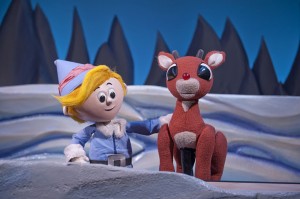
Hermey and Rudolph have a special bond. Photo by Clay Walker
Amick: [Director] Jon Ludwig talks a lot about how we can’t change these characters because they’re so well known and well loved, but their lives are becoming more complete because we see them at all times and see their reactions to things that we frequently don’t see in the show. It’s like, “What are they doing the rest of the time? What kind of people are they? How do they react?” Jon Ludwig brought up the concept of deepening the characters rather than widening or broadening them. We don’t want to make them wackier, we’re just trying to find what is making them tick a little more.
The show has a very strong rhythm to it. It’s not only the same team of puppeteers, it’s also the same stage manager running all the cues. Even with variations in people’s performances, everybody feels each other so strongly that it really has a very definite rhythm.
That being said, if somebody saw it last year I’d encourage them to see it again because they’re sure to see something they didn’t see before. There’s so much going on, it’s kind of overwhelming the first time. With repeated viewings you’ll say, “Oh, I never noticed that elf in the background hitting that other elf with a brush” or something. Everybody’s doing something.
I noticed more of the background stuff this year and was sometimes more entertained by that than the main action. And since most people already know the story so well, it’s fun to check out the other details more.
Amick: It’s funny how those bits take on a whole story of their own. We’re trying desperately not to distract or call attention to ourselves, but the sequence of events has naturally and organically happened. Now it’s pretty elaborate.
How closely was Character Arts, which owns the Rudolph license, involved with the production?
Scarborough: Last year, with the original production, they were involved very closely. They were in constant contact with Jason von Hinezmeyer, the builder, and he had to get approval for all of his designs and every color choice to make it as close to the original look as possible. They worked very closely with Jon Ludwig, who adapted the script. We were all pretty nervous when a Character Arts representative came to see the show last year. But that was one of the most rewarding moments of the run because he loved it. He knows these characters better than anybody; that’s his whole job. But he was so impressed with what we had done, the look of the show, the way the actors and puppeteers portrayed it, so it was very flattering and we were all very relieved to get his stamp of approval.
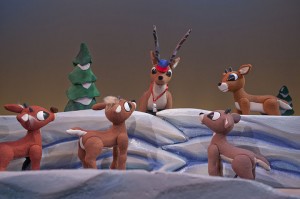
Rudolph tries to join in the reindeer games. Photo by Clay Walker
It is very faithful to the original teleplay. There are a few things that got switched around for continuity’s sake. In TV, you can do quick cuts and go back and forth very quickly. During the reindeer games scene, where Rudolph is with the coach, they do cuts back and forth between Rudolph and Hermey’s saga of wanting to be a dentist with the elves making fun of him. Because it takes a lot of effort to change the set from one thing to another, we run the entire reindeer games scene, then we go into the entire Hermey scene. But unless someone has watched the special with rapt attention every minute, they probably wouldn’t catch that.
Amick: I think one of the only significant alterations is that in the original show the women are constantly getting left at home and there’s lots of “We’d better get the women back to Christmas Town” and stuff like that. Whereas in our show, there are so few female characters in the show that the ones we have are a little more proactive. For example, Rudolph’s mom and Clarice both go out to look for him and fight the monster in a way that they didn’t in the show. But it makes a lot of sense that they would. It’s not like we made a crazy choice, it’s just, like, this part is a little dated in a way that’s weird.
Scarborough: I think that’s also a product of the fact that you can see all the characters all the time. When I’m playing Mrs. Donner – in the television show you can only see Rudolph and Donner having their interaction – since I’m there on stage, as much as I can without stealing focus, I react and I’m more on Rudolph’s side. I’d rather him be able to express himself and be his own deer. But my husband obviously has different ideas, so I can kind of express that tension a little bit as subtly as I can.
Another sort of dated thing that, with Character Arts, we weren’t able to do was Jon would have liked to have had an elf of color. Character Arts would not permit that and were very insistent that the look of all the puppets be exactly as they appeared on screen in 1964.
Given the success of this show, has there been any talk of adapting any other Rankin/Bass animated shows?
Scarborough: I don’t know if that’s been discussed yet, but I’m certain that they’re open to that. Stop motion animation is it’s own form of puppetry and we had the original Rudolph and Santa puppets from when it was made in 1964 on display in our museum area a few years ago.
Amick: I remember that crazy Peter Cottontail with Irontail. I’d like to do Santa Claus is Comin’ to Town. That’s a good one. It’s the one where he’s a redhead and has Mickey Rooney’s voice.
Outside of collaborating on puppet shows like this one, you are also both involved with Platinum Championship Wrestling in some unique ways. Oddly, there are quite a few people from the Center for Puppetry Arts who are also involved with PCW. Why do you think that is?
Scarborough: I have to take responsibility for that. I married my husband and your spouse’s friends become your friends and we started to run in the same circles. We’re both in the performance industry and in this city a lot of people know each other, especially in theatrical performance circles. You wind up seeing the same actors in various theaters around town and you get to know the creative community. Because Steve married me, he gained a lot of knowledge of the Atlanta theatre community. He already had a lot of knowledge of wrestling, so he found another pool of talent to draw from such as Dolph, for example, for composing music.
Amick: Not only is there a lot of overlap because a lot of us know each other from the theatre scene, but puppetry and wrestling as performance types still sit in some kind of fringe area. So there’s still some kind of avant garde-ness or edginess or street character to it. I don’t know how to put it, but there’s definitely a sense of doing something risky that’s not quite mainstream. I can see where the types of things that appeal to people in one forum frequently appeal to people in the other. Plus we have a lot of friends in the improv scene, which is huge for the wrestlers.
Scarborough: A lot of wrestling is improvisation. It isn’t scripted the way a play is. They’re living and acting as their characters.
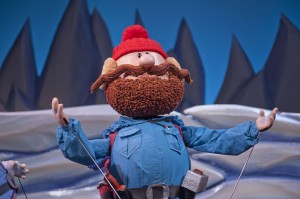
Dolph Amick strikes gold as Yukon Cornelius. Photo by Clay Walker
Amick: Our artistic director, who directed this show, is a tremendous wrestling fan. He is utterly fascinated by the combination of drama and spectacle and improvisation. It gets him all giddy. Like a lot of wrestling fans, he finds it exciting and hilarious and crazy and enthralling and compelling. Actually, several years ago, he did a [puppet] show called Wrestling Macbeth. I remember how startled I was to bump into him at PCW with his wife and he was there week after week, just digging the shows and having the best time.
Speaking from a composing point of view, Steve frequently will have a pretty clear idea for something really character driven that we can work on. But he also is very appreciative of how much drama and impact the music can add to the spectacle without overloading the audience with flashy lights and explosions. We take the spectacle to a degree that’s possible with the budget we have, but also puts the emphasis on the wrestlers. The music, being an intangible thing, can have a tremendous effect and I really appreciate that he is very aware of the effect it has.
You did a lot of the music for the PCW guys, some of which aren’t around as often as they used to be. Have you done any work more recently for PCW or for Empire Wrestling now that it has taken over?
I got really busy for a while, but every once in a while if some really critical moment comes up, I’ll get a call from Steve and he’ll be like, “We’ve got to have something special for this.” I’m always looking to write more, but I think the most recent thing was we did some stuff for Sacred Ground: Chapter 2. We beefed up the theme for Mason, who is now the PCW Champion, and gave him a heavier theme. I also did Marko Polo’s new theme. And now I’m doing stuff for Master Jae and, now that Shane Marx has joined the Empire, we decided that needed to be commemorated musically in some way.
For more information, go to www.puppet.org.

